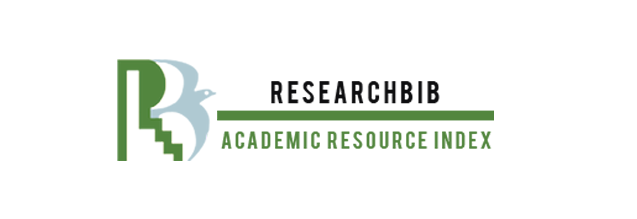Impulsionadores e barreiras da participação das mulheres nas atividades agrícolas na Nigéria
DOI:
https://doi.org/10.36812/pag.2022281156-173Palavras-chave:
Impulsionadores da participação, Regressão Logit ordenada, Mulheres agricultorasResumo
O estudo examinou os impulsionadores da participação das mulheres nas atividades agrícolas na Nigéria. Um total de 636 mulheres agricultoras foram utilizadas para o estudo e os dados foram coletados por meio de entrevista e questionário. Estatística descritiva, índice de participação e regressão Logit Ordenado foram utilizados para analisar os dados. Os resultados revelaram que a média de idade, tamanho do agregado familiar, experiência agrícola e tamanho da propriedade foram de 44 anos, 8 membros, 18 anos e 3,1 ha, respectivamente. O resultado também revelou que as mulheres agricultoras na Nigéria se engajaram em atividades agrícolas, como agricultura, pecuária, comércio agrícola, avicultura, horticultura e aquicultura. O resultado do índice de participação revelou que as agricultoras estavam ativamente envolvidas na agricultura com 49,06 % das mulheres com alto nível de participação. A análise de regressão revelou que os impulsionadores positivos da participação das mulheres nas atividades agrícolas foram o tamanho do agregado familiar, estado civil, nível de educação, experiência agrícola, rendimento disponível, serviço de extensão e associação a associações. Ao contrário, a distância da fazenda é um fator negativo da participação das mulheres nas atividades agrícolas na área de estudo. Além disso, oportunidades financeiras inadequadas e acesso inadequado a serviços de extensão estavam entre as sérias restrições que dificultavam a participação das mulheres nas atividades agrícolas.
Downloads
Referências
ANEKE C. U.; ALIO A. N. Women participation in agriculture, prospects and challenges for increased food production. British journal of education, v. 6, n. 11, p. 29-35, 2018.
BANJI, O. A.; OKUNADE, E. O. Women in agriculture and rural development. Agricultural Extension Society of Nigeria Journal, v. 6, n. 1, p. 90 -100, 2011.
BEACH, S. S. Farmers views on women in Kansas farming households. Rural Sociology, v. 78, n. 2, p. 201-228, 2013. DOI: https://doi.org/10.1111/ruso.12008. DOI: https://doi.org/10.1111/ruso.12008
CHENG, J.; KARAMBELKAR, B.; XIE, Y. Leaflet: create interactive web maps with the JavaScript 'Leaflet' Library. R package version 2.0.1. Available at: https://CRAN.R-project.org/package=leaflet. 2018. Accessed on 15 June 2022.
COMMON WEALTH. Commonwealth priorities for gender equality and women’s empowerment 2017-2020 and beyond. Paper presented at the 11th women affairs ministers’ meeting, commonwealth secretariat, Samoa. 2016.
EVERS, B.; WALTERS, B. Extra-household factors and women farmers supply response in Sub-Saharan Africa. World Development, v. 28, n. 7, p. 1341-1345, 2000. DOI: https://doi.org/10.1016/S0305-750X(00)00022-X
FIRAFIS, H. D. Factors affecting women farmers’ participation in agricultural extension services for improving the production in rural district of Dendi West Zone and Shoa Zone, Ethiopia. International Journal of Agricultural Research, Sustainability and Food Sufficiency, v. 3, n. 4, p. 69-82, 2016. DOI: https://doi.org/10.15740/HAS/IJHSECM/3.2/59-71. DOI: https://doi.org/10.15740/HAS/IJHSECM/3.2/59-71
FAO. Food and Agriculture Organization. HIV/AIDS and agriculture: impacts and responses. FAO, Rome. 2003.
FAO. Food and Agriculture Organization. The state of food and agriculture 2010-2011: Women in agriculture, closing the gender gap for development. Rome, Food and Agriculture Organization of the United Nation. 2011.
FAO. Food and Agriculture Organization. FAO Statistical Yearbook: World food and agriculture, Food and Agriculture Organization of the United Nations, Rome. Available at: http://www.fao.org/docrep/018/i3107e/i3107e00.htm. 2013. Accessed on 3 October 2021.
FAO. Food and Agriculture Organization. FAO policy on gender equality 2020-2030. 2020. Available at: www.fao.org/3/cb1583en/cb1583en.pdf. Accessed on 3 October 2021.
GREEN, W. H. Econometrics Analysis, 4th Edition, Prentice Hall International, New York. 2000.
HUMAN DEVELOPMENT REPORT. The next frontier: Human development and the anthropocene. Briefing note for countries on the 2020 Human Development Report. Available at: https://www.google.com/aclk?sa=l&ai=DChcSEwiv4YXY0OH4AhWq-NUKHS8JBbUYABAAGgJ3cw&ae=2&sig=AOD64_2nQTpmUp1l3DxbuCri6r1RWrfdlg&q&adurl&ved=2ahUKEwjwrvnX0OH4AhVBXvEDHaPlDJ4Q0Qx6BAgCEAE. Accessed on 2 October, 2021.
IWENA, O. A. Essentials of Agricultural Science for Senior Secondary Schools Ogun. Tonad publishers. 2015.
JIRIKO, R. K. Socio-economic factors affecting the performance of women in food production. Global Journal of Agricultural Resources, v. 3, n. 2, p. 37-45, 2015.
LUQMAN, M. et al. Extent of rural women’s participation in agricultural activities. International Journal of Agricultural Management and Development, v. 2, n. 1, p. 1-8, 2012. DOI: https://doi.org/10.22004/ag.econ.164125.
NBS. National Bureau of Statistics. Nigeria GDP-2021 data. 2022. Available at: https://www.nigerianstat.gov.ng. Accessed on 2 October 2021.
NHC. Nigeria High Commission. Nigeria geography, climate and vegetation. Available at: http://www.nigeriahc.org.uk/about-nigeria. Accessed on 1 October 2021.
OGUNLELA, Y. I.; MUKHTAR, A. A. Gender issues in agricultural and rural development in Nigeria: The role of women. Humanity & Social Sciences Journal, v. 4, n. 1, p. 19-30, 2009.
OLADEJO, J. A.; OLAWUYI, S. O.; ANJORIN, T. D. Analysis of women participation in agricultural production in Egbedore local government area of Osun State, Nigeria. International Journal of Agricultural Economics & Rural Development, v. 4, n. 1, 1-9, 2011.
ORANU, C. O. et al. Comparative evaluation of farmers’ perception and adaptation strategies to climate change and variability in Bako Tibe, Ethiopia and Abeokuta Nigeria. American Journal of Climate Change, v. 7, n. 4, 1-13, 2018. DOI: https://doi.org/10.4236/ajcc.2018.74038. DOI: https://doi.org/10.4236/ajcc.2018.74038
OSANYINLUSI, O. I.; ADENEGAN, K. O. The determinants of rice farmers’ productivity in Ekiti State, Nigeria. Greener Journal of Agricultural Sciences, v. 6, n. 2, p. 49-58, 2016. DOI: https://doi.org/10.15580/GJAS.2016.2.122615174
OSUJI, F. New Role of ICT in National Development. 2015. Vanguard 19th Jan. Retrieved 17th October, 2021.
OWOLABI, J. O.; ABUBAKAR, B. Z.; AMODU, M. Y. Assessment of farmers (women) access to agricultural extension, inputs and credit facility in Sabon-Gari local government area of Kaduna State. Nigerian Journal of Basic and Applied Science, v. 19, n. 1, p. 87-92, 2013. DOI: https://doi.org/10.4314/njbas.v19i1.69350. DOI: https://doi.org/10.4314/njbas.v19i1.69350
QUISUMBING, A. R., et al. Closing the knowledge gap on gender in agriculture. Gender in Agriculture, v. 1, n. 1, p. 3-27, 2014. DOI: https://doi.org/10.1007/978-94-017-8616-4_1. DOI: https://doi.org/10.1007/978-94-017-8616-4_1
SADP. States Agricultural Development Project. National Farmers Data Base. 2021.
SALLAWU, H. Effects of adaptive capacity to climate change on livelihood diversification of farmers under IFAD-VCDP in North Central Nigeria. 2021. Unpublished Ph.D thesis submitted to Department of Agricultural Economics and Farm Management, Federal University of Technology Minna, Nigeria, 2021.
SOUBH, S. Women’s role in agriculture and gender related issues in Syria. National Agricultural Policy Centre (NAPC) working paper No. 18. Syria: NAPC. 2006.
SOYEMI, O. D. Women farmers’ agricultural information need and search behaviour in North Central Nigeria. Information and Knowledge Management, v. 4, n. 8, p. 1-10, 2014.
TIJANI, B. A.; Tijjani, H. Socio-economic factors influencing women participation in agricultural productivity in Damaturu local government area, Yobe State, Nigeria. International Journal of Economics, Commerce and Management, v. 7, n. 12, 416-429, 2019.
UZOKWE, U. N.; OFUOKU, A. U.; DAFE, O. D. Male and female participation in selected agricultural development programmes in Edo State. Journal of Agricultural Extension, v. 21, n. 1, p. 15-26, 2017. DOI: https://doi.org/10.4314/jae.v21i1.2 DOI: https://doi.org/10.4314/jae.v21i1.2
WORLD BANK. World Bank Open Data: free and open access to global development data. 2020. Available at: http://data.worldbank.org. Accessed on 1 October 2021.
Downloads
Publicado
Como Citar
Edição
Seção
Licença
Os autores declaram que o trabalho não foi publicado anteriormente, nem enviado simultaneamente para publicação em outro periódico e que concordam com a submissão, conteúdo e transferência dos direitos de publicação do artigo em questão para o periódico científico Pesquisa Agropecuária Gaúcha - PAG. Os autores assumem total responsabilidade pela originalidade do artigo, podendo incidir sobre os mesmos, eventuais encargos decorrentes de reivindicação, por parte de terceiros, em relação à autoria do artigo.
A reprodução total dos artigos da Revista em outros meios de comunicação eletrônicos de uso livre é permitida de acordo com a licença Creative Commons Atribuição-NãoComercial-CompartilhaIgual 4.0 Internacional.




















